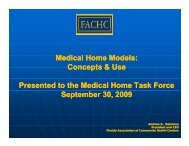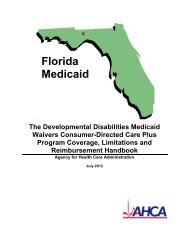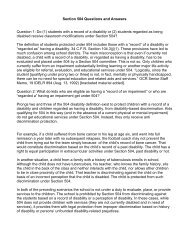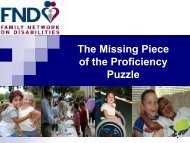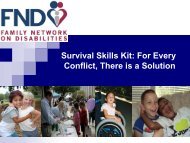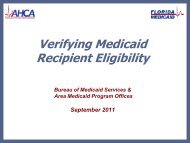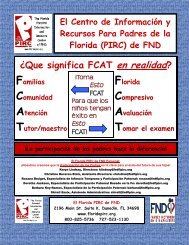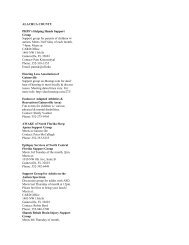Positive Beginnings With PBS - The Family Network on Disabilities ...
Positive Beginnings With PBS - The Family Network on Disabilities ...
Positive Beginnings With PBS - The Family Network on Disabilities ...
You also want an ePaper? Increase the reach of your titles
YUMPU automatically turns print PDFs into web optimized ePapers that Google loves.
<str<strong>on</strong>g>Positive</str<strong>on</strong>g> <str<strong>on</strong>g>Beginnings</str<strong>on</strong>g> <str<strong>on</strong>g>With</str<strong>on</strong>g> <str<strong>on</strong>g>PBS</str<strong>on</strong>g>
• <str<strong>on</strong>g>Family</str<strong>on</strong>g> Driven• N<strong>on</strong>-Profit 501(c)3<str<strong>on</strong>g>Family</str<strong>on</strong>g> Driven: What makes FND unique is that the majority of our Board ofDirectors, and Management Staff and all of our Program Staff are parents orfamily members of pers<strong>on</strong>s with disabilities.When family members call FND, they not <strong>on</strong>ly receive the expertise andknowledge of a professi<strong>on</strong>al, but also the compassi<strong>on</strong> and empathy ofsome<strong>on</strong>e who has walked (and c<strong>on</strong>tinues to walk) in their shoes.
♥♥We do NOT:Act As AttorneysWe DO:♥ Provide SupportProvide Informati<strong>on</strong>Help Identify Opti<strong>on</strong>sAct as Attorneys: We d<strong>on</strong>’t represent families, and we d<strong>on</strong>’t give legal advice.Support: FND has been the statewide Parent to Parent since 1985, and the value of familiesgetting support by networking with other families is built into everything we do. We often get callsfrom parents or other family members who just need to talk – and we’re there to listen.Informati<strong>on</strong>: Altogether, FND logs over 15,000 calls a year, most of them from parents, familymembers, or professi<strong>on</strong>als who are looking for informati<strong>on</strong>. We have a large database of resourcesin Florida, and a library filled with disability-related informati<strong>on</strong>. Regardless of the questi<strong>on</strong>, ourstaff will go the extra mile to find an answer.Identify Opti<strong>on</strong>s: Our philosophy at FND is that it is not our role to tell families what to do. It is ourrole, however, to inform families of what their opti<strong>on</strong>s are – and encourage them to make their owndecisi<strong>on</strong>s about what is right for their family.
What is <str<strong>on</strong>g>Positive</str<strong>on</strong>g> Behavior Support (<str<strong>on</strong>g>PBS</str<strong>on</strong>g>)?• Collaborative approach• <str<strong>on</strong>g>Positive</str<strong>on</strong>g> strategies• Interventi<strong>on</strong> for children withinappropriate behaviors<str<strong>on</strong>g>Positive</str<strong>on</strong>g> Behavior Support, <str<strong>on</strong>g>PBS</str<strong>on</strong>g>, is a collaborative approach to developing effective supports andinterventi<strong>on</strong>s – which may include parents, teachers, a behavior analyst, school psychologist,therapists, or any<strong>on</strong>e else that comes into c<strong>on</strong>tact with the child. <str<strong>on</strong>g>The</str<strong>on</strong>g> key to the success of a<str<strong>on</strong>g>PBS</str<strong>on</strong>g> program is its c<strong>on</strong>sistent applicati<strong>on</strong> across all settings-home, school and community.<str<strong>on</strong>g>The</str<strong>on</strong>g> underlying c<strong>on</strong>cept of <str<strong>on</strong>g>Positive</str<strong>on</strong>g> Behavior Support an approach that blends values about therights if individuals with disabilities with an understanding of how learning and behavior changeoccurs.
Individuals with <strong>Disabilities</strong> Educati<strong>on</strong> ActDevelopment of the IEP 300.346<str<strong>on</strong>g>The</str<strong>on</strong>g> IEP team shall –(2)(i) In the case of a child whose behavior impedes hisor her learning or that of others, c<strong>on</strong>sider, ifappropriate, strategies, including positive behavioralinterventi<strong>on</strong>s, strategies, and supports to addressthat behavior.<str<strong>on</strong>g>Positive</str<strong>on</strong>g> behavior support is specifically menti<strong>on</strong>ed within the Individuals with<strong>Disabilities</strong> Educati<strong>on</strong> Act (IDEA) as an interventi<strong>on</strong> for children withinappropriate behaviors.IDEA states that if a child’s behavior interferes with the learning of a skill or thelearning of others, <str<strong>on</strong>g>PBS</str<strong>on</strong>g> can be accessed as a related service.
Individuals with <strong>Disabilities</strong> Educati<strong>on</strong> ActRelated Services602 (26)“Developmental, corrective, and other supportiveservices as may be required to assist a child with adisability to benefit from special educati<strong>on</strong>.”A related service, according to IDEA, is any service that a child may need tobenefit from special educati<strong>on</strong>. Related services are identified by the IEP teamand written into the IEP under each goal.An IEP goal that addresses a child’s behavior or his or her participati<strong>on</strong> in classdirectly related to behavior, might have <str<strong>on</strong>g>PBS</str<strong>on</strong>g> listed as a related service, to assistthe child to achieve that goal.
Individuals with <strong>Disabilities</strong> Educati<strong>on</strong> ActLeast RestrictiveEnvir<strong>on</strong>ment300.550“To the maximum extent appropriate, children withdisabilities … are educated with children who arenot disabled.”Another provisi<strong>on</strong> in IDEA relates to Least Restrictive Envir<strong>on</strong>ment.Special classes, separate schooling, or other removal of children with disabilities from theregular educati<strong>on</strong>al envir<strong>on</strong>ment should occur <strong>on</strong>ly if the nature or severity of a child’sdisability is such that educati<strong>on</strong> in regular classes with the use of supplementary aids andservices cannot be achieved satisfactorily.Factors that exclude a child from a regular educati<strong>on</strong> placement include:- if the child is a harm to himself or others;- if his or her behavior is disruptive to impede the learning of others; or- if the curriculum were to be modified bey<strong>on</strong>d recogniti<strong>on</strong>.<str<strong>on</strong>g>Positive</str<strong>on</strong>g> Behavior Support is a related service that should be utilized before moving a childto a more restrictive envir<strong>on</strong>ment.
Why use <str<strong>on</strong>g>PBS</str<strong>on</strong>g>?Traditi<strong>on</strong>al Discipline Strategies•Reactive in nature•Oriented toward short-term changes•Punishing students without positive supports resultsin increased aggressi<strong>on</strong>, vandalism, truancy, anddropouts•(Mayer & Sulzer-Azaroff, 1991)Why use <str<strong>on</strong>g>PBS</str<strong>on</strong>g>? First let’s take a look the strategies that have been used in the past.Typically, in the past, discipline has taken place after each occurrence of an inappropriatebehavior, instead of planning ahead with positive strategies to avoid the behavior before ithappens. Providing negative c<strong>on</strong>sequences after a behavior occurs may change thebehavior for a short time for a particular situati<strong>on</strong>, but may not be enough. <str<strong>on</strong>g>PBS</str<strong>on</strong>g> includesstrategies to teach the child appropriate behaviors that can be used repeatedly or in othersettings.According to a study that took place over 15 years ago in 1991, punishing students withoutpositive supports doesn’t work. In fact, overall it makes the situati<strong>on</strong> worse, not better.
Why use <str<strong>on</strong>g>PBS</str<strong>on</strong>g>?If a child doesn’t know how to read, we teach.If a child doesn’t know how to swim, we teach.If a child doesn’t know how to multiply, we teach.If a child doesn’t know how to drive, we teach.If a child doesn’t know how to behave, we……….teach? we………punish?Herner, 1998Why can’t we finish the last sentence as automatically as we do the others?
Why use <str<strong>on</strong>g>PBS</str<strong>on</strong>g>?•Educators have a right to asafe envir<strong>on</strong>ment in which toteach.•Students have a right to asafe envir<strong>on</strong>ment in which tolearn.Teachers choose to be teachers because they want to make a difference in children’s lives.It has always been difficult for teachers to balance their roles as both teacher anddisciplinarian.If the traditi<strong>on</strong>al strategies have been found to lead to increased aggressi<strong>on</strong>, then it’s time toimplement new strategies that will decrease behaviors and the risk of violence in theclassroom.Our teachers have a right to a safe envir<strong>on</strong>ment in which to teach.Our students have a right to a safe envir<strong>on</strong>ment in which to learn.
Before <str<strong>on</strong>g>PBS</str<strong>on</strong>g> - <str<strong>on</strong>g>The</str<strong>on</strong>g> Process1.) Observe the behaviorBehaviors can <strong>on</strong>ly be definedwhen they are.…OBSERVABLE&MEASURABLEBefore developing a <str<strong>on</strong>g>Positive</str<strong>on</strong>g> Behavior Support plan, there is a process that is typically followed.<str<strong>on</strong>g>The</str<strong>on</strong>g> first step in the process is to observe and define a particular unacceptable behavior. Ofcourse, <strong>on</strong>e child may have many inappropriate behaviors, but when working toward a plan for<str<strong>on</strong>g>PBS</str<strong>on</strong>g>, addressing <strong>on</strong>e behavior at a time may be more successful.To define a behavior, it must be observable – a pers<strong>on</strong> must be able to see, hear, or feel thebehavior.It must also be measurable, such as how often does it happen, how l<strong>on</strong>g does it last.
Before <str<strong>on</strong>g>PBS</str<strong>on</strong>g> - <str<strong>on</strong>g>The</str<strong>on</strong>g> ProcessTry interventi<strong>on</strong>sBehavior interventi<strong>on</strong> planCrisis interventi<strong>on</strong> plan, if necessaryCollect dataFuncti<strong>on</strong>al Behavioral Assessment<str<strong>on</strong>g>The</str<strong>on</strong>g> sec<strong>on</strong>d step in the process would be to try interventi<strong>on</strong>s – the situati<strong>on</strong> may beresolved by something as simple as moving the child to a different seat within theclassroom.A plan may be developed for dealing with the unacceptable behavior while interventi<strong>on</strong>s arebeing tried. <str<strong>on</strong>g>The</str<strong>on</strong>g> plan might be developed by the teacher.If the child’s behavior is dangerous to himself or others, he or she may need a crisisinterventi<strong>on</strong> plan.During this period the behavior in questi<strong>on</strong> will be tracked. School pers<strong>on</strong>nel who observethe behavior will log how often it occurs, for what durati<strong>on</strong>, and at what intensity.If the interventi<strong>on</strong>s are not successful, a behavior analyst or a school psychologist willc<strong>on</strong>duct a Functi<strong>on</strong>al Behavioral Assessment.
Functi<strong>on</strong>al Behavioral Assessment(FBA)Purpose: To determine the causes of abehavior and identify likely interventi<strong>on</strong>s.A functi<strong>on</strong>al behavioral assessment, FBA, determines not <strong>on</strong>ly what the behaviors are, butalso the functi<strong>on</strong> of the behavior.An FBA is an evaluati<strong>on</strong>. IDEA requires that c<strong>on</strong>sent must be obtained from the parentbefore an evaluati<strong>on</strong> is c<strong>on</strong>ducted.<str<strong>on</strong>g>The</str<strong>on</strong>g> purpose of a FBA is to identify:Clearly the problem behaviors<str<strong>on</strong>g>The</str<strong>on</strong>g> triggersAnd the c<strong>on</strong>sequences that maintain the behavior
Behaviors c<strong>on</strong>tinue……because theyhave a purpose orfuncti<strong>on</strong>.Children engage in a behavior because they have learned that a desiredoutcome occurs. <str<strong>on</strong>g>The</str<strong>on</strong>g>y c<strong>on</strong>tinue to exhibit behavior because they c<strong>on</strong>tinue toreceive the desired outcome. <str<strong>on</strong>g>The</str<strong>on</strong>g>y get something desirable or pleasant or theyavoid something undesirable or unpleasant
Behavior usually serves <strong>on</strong>e of twofuncti<strong>on</strong>s:TO GET or TO AVOIDExamples:•To get attenti<strong>on</strong>•To avoid homework•To get dessertSometimes the functi<strong>on</strong> of a behavior is not obvious – or at first look, what seems the likely reas<strong>on</strong> for thebehavior may not be the reas<strong>on</strong> at all. A functi<strong>on</strong>al behavioral assessment, through observati<strong>on</strong> and datacollecti<strong>on</strong>, attempts to pinpoint the underlying cause of the behavior – usually what the child is trying toget or avoid.– To avoid doing math – In this example, <strong>on</strong>e might assume that this girl doesn’t know how to do the mathproblem <strong>on</strong> the board. Further observati<strong>on</strong> might show that she actually does know how to complete theproblem, but w<strong>on</strong>’t do math problems in fr<strong>on</strong>t of the class.– To get attenti<strong>on</strong> – Children who have a need for attenti<strong>on</strong> will look for either positive or negativeattenti<strong>on</strong>.– To avoid homework – Sometimes it’s difficult to determine just why a teenager might pick a fight withher mother. Arguing with Mom, complete with the typical teenage eye roll, is better than doing sciencehomework.– To get dessert – I’m betting this girl got what she wanted.
FBA – Observe & Record:A B CAntecedentsBehaviorC<strong>on</strong>sequencesDuring the FBA, data must be collected to determine the functi<strong>on</strong> or c<strong>on</strong>sequence of thebehavior. <str<strong>on</strong>g>The</str<strong>on</strong>g>re are a number of ways to collect informati<strong>on</strong>. <str<strong>on</strong>g>The</str<strong>on</strong>g> ABC process is widelyused.<str<strong>on</strong>g>The</str<strong>on</strong>g> letters stand for…A= Antecedent (what happens before a behavior)B= Behavior (the observable and measurable acti<strong>on</strong>)C= C<strong>on</strong>sequence (what occurred after the acti<strong>on</strong> to maintain the acti<strong>on</strong> or increase thefrequency)
AntecedentsWho is present when the behavioroccurs?What is going <strong>on</strong> when the behavioroccurs?Where does the behavior occur?Antecedent simply means “what happened right before.”Some questi<strong>on</strong>s that might be asked during a Functi<strong>on</strong>al Behavioral Assessment would be:Who was there?What was going <strong>on</strong>?Where did it happen?By asking these questi<strong>on</strong>s and tracking their answers with each time the behavior occurs,the FBA can identify comm<strong>on</strong> circumstances. For example, a certain behavior might occurevery time the child is bored, like this girl.
BehaviorHow often does the behavior occur,per hour, per day, per week?How l<strong>on</strong>g per episode?How intense?During the FBA, the behavior itself will be closely m<strong>on</strong>itored and tracked,including how often it occurred, how l<strong>on</strong>g the it lasted each time it occurred, andhow intense the behavior was during each occurrence, such as how loud,agitated or violent.
C<strong>on</strong>sequencesWhat happens right after the behavior occurs?Under what circumstances does the behavior stop?Under what circumstances does the behavior seldom ornever occur?Where does the behavior seldom or never occur?What the usual c<strong>on</strong>sequence of a behavior is can tell us a lot about the functi<strong>on</strong>of a behavior. Since a behavior is caused by a desired outcome, what usuallyhappens right after a behavior occurs? For example, if every time the girl in thepicture has a temper tantrum, she gets sent home – getting sent home might verywell be her “desired outcome,” and the functi<strong>on</strong> of that behavior.Other questi<strong>on</strong>s about the c<strong>on</strong>sequences of a behavior might include: when doesthe behavior stop? What is going <strong>on</strong> when the behavior stops?It is also helpful to know when and where the behavior never occurs. Since thedesired outcome is not always obvious, the functi<strong>on</strong>al behavior assessmentcollects as many clues as possible, to help determine the underlying functi<strong>on</strong>.
Parent Input in the FBA• Parents know their children best• Parents often know what the functi<strong>on</strong> of thebehavior is, as they may have seen thebehavior occur outside of the school setting.• Input from the family is collected <strong>on</strong> a form orby interview.<str<strong>on</strong>g>The</str<strong>on</strong>g> more clues that are collected, the more accurate the Functi<strong>on</strong>al BehavioralAssessment will be. Gathering informati<strong>on</strong> from the parents during an FBA willbroaden the FBA to include behaviors that do – and d<strong>on</strong>’t – occur at home.Also, parents often know the functi<strong>on</strong> of a behavior, just because they’ve seenthose behaviors evolve since their child was a baby.<str<strong>on</strong>g>The</str<strong>on</strong>g> school psychologist or Certified Behavior Analyst might interview the parents,or they might be invited to share their input in writing.Also, input from teachers and other staff such as bus drivers or aides couldcertainly be helpful in obtaining an accurate picture of a child’s behaviors.
Behaviors are…signaled by anAntecedent,thenreinforced byC<strong>on</strong>sequencesBecause behaviors are signaled by an antecedent, generally to obtain the samec<strong>on</strong>sequence each time, <strong>on</strong>ce the functi<strong>on</strong> of the behavior is known, the behaviorbecomes predictable.If we can predict it, we can plan for it.
<str<strong>on</strong>g>Positive</str<strong>on</strong>g> Behavior Support Plan• Analysis of FBA data• Educated Guess: functi<strong>on</strong> of thebehavior• Plan for predicting and replacingbehaviorOnce the Functi<strong>on</strong>al Behavioral Assessment is complete, then the School psychologist or CertifiedBehavior Analyst analyzes the data. <str<strong>on</strong>g>With</str<strong>on</strong>g> all that informati<strong>on</strong>, he or she makes an educated guess aboutthe functi<strong>on</strong> or cause of the behavior.Because the best any<strong>on</strong>e can do is guess what the functi<strong>on</strong> of a behavior is, the <strong>on</strong>ly way to know forsure is to create a plan based <strong>on</strong> that guess, implement the plan, and document the results.<str<strong>on</strong>g>The</str<strong>on</strong>g> Informati<strong>on</strong> from the FBA process is used to support teams to develop and implementcomprehensive interventi<strong>on</strong>s. <str<strong>on</strong>g>PBS</str<strong>on</strong>g> plans usually include multiple strategies that include 1) proactivestrategies for changing the envir<strong>on</strong>ment so triggering events are removed 2) teaching new skills thatreplace problem behaviors 3) eliminate or minimize natural rewards for problem behaviors and 4)maximizing clear rewards for appropriate behaviors.
<str<strong>on</strong>g>Positive</str<strong>on</strong>g> Behavior Support Plan• Determine positive replacement behaviors that:• allow the child to achieve the same functi<strong>on</strong> that thenegative behavior achieved, or• allow the child to achieve a greater functi<strong>on</strong> than thenegative behavior achieved.<str<strong>on</strong>g>The</str<strong>on</strong>g> development of positive replacement behaviors is the core of the <str<strong>on</strong>g>Positive</str<strong>on</strong>g>Behavior Support plan.<str<strong>on</strong>g>The</str<strong>on</strong>g> c<strong>on</strong>cept of <str<strong>on</strong>g>PBS</str<strong>on</strong>g> is to teach replacement behaviors that will ultimately providethe desired outcomes that the child wanted in the first place OR……that will provide another desired outcome that is even better than the <strong>on</strong>e he orshe wanted in the first place.
<str<strong>on</strong>g>Positive</str<strong>on</strong>g> Behavior Support Plan• Plan includes how the new behaviors will be taught.-Strategies• Manipulate the antecedent• Manipulate the c<strong>on</strong>sequences-Services• Special instructi<strong>on</strong> or other related servicesOnce replacement behaviors have been determined, a plan must be made for how the childwill learn and begin to implement those behaviors. Strategies will be identified, such as:-Manipulating the antecedent, such as planning the child’s day carefully so that she neverreaches the level of boredom that triggers the behavior; or-Manipulating the c<strong>on</strong>sequences, such as ignoring the tantrum and NOT sending the childhome from school, but offering a reward for acceptable behavior that is more desirable thangoing home. <str<strong>on</strong>g>The</str<strong>on</strong>g> informati<strong>on</strong> collected during the FBA will help in identifying rewards thatare individualized and unique to the child.<str<strong>on</strong>g>The</str<strong>on</strong>g> plan may also include the identificati<strong>on</strong> of specific services that will support the childlearning the replacement behaviors, such as special instructi<strong>on</strong> or counseling.
<str<strong>on</strong>g>Positive</str<strong>on</strong>g> Behavior Support Plan• Plan can also include a specific crisisplan, if necessary• <str<strong>on</strong>g>The</str<strong>on</strong>g> plan must be achievable:-Is the child capable of changing that behavior or isit his or her disability?In some cases, it may be necessary for the IEP team to develop a crisis/emergency plan toaddress a severe or dangerous situati<strong>on</strong>.A crisis can be defined as a situati<strong>on</strong> that requires an immediate, intrusive, or restrictiveinterventi<strong>on</strong> to: 1) protect the student or others from serious injury; 2) safeguard physicalproperty; and/or 3) deal with acute disturbance of the teaching/learning process.<str<strong>on</strong>g>The</str<strong>on</strong>g> plan must be achievable. When a child has a behavior that is a manifestati<strong>on</strong> of theirdisability, it may not be realistic to expect the child to change the behavior itself.
“Is it his/her disability?”• Examples:ADHD or Bipolar DisorderPost Traumatic Stress DisorderDevelopmental disabilitiesFor example, if a disability is medically or neurologically based, it might be treated withmedicati<strong>on</strong>s, which may reduce or cause behaviors. A child whose disability was caused byemoti<strong>on</strong>al trauma or envir<strong>on</strong>mental factors may benefit from counseling or therapy – andbecause of the nature of their disability, may not be able or ready to change a certainbehavior. A child with a developmental disability may not have the ability to alter thebehavior by using a replacement behavior.<str<strong>on</strong>g>The</str<strong>on</strong>g> plan should acknowledge that <str<strong>on</strong>g>PBS</str<strong>on</strong>g> cannot cure a disability. A child who is deaf or blindand has behaviors that are a direct result of their deafness or blindness, will not have theability to change those behaviors.Even if the child is unable to change a behavior, a plan could still address strategies such asmanipulati<strong>on</strong> of the antecedent to avoid situati<strong>on</strong>s that will trigger the behavior.
<str<strong>on</strong>g>PBS</str<strong>on</strong>g> Plan Comp<strong>on</strong>entsProactive: change the envir<strong>on</strong>mentEducative: teach skillsFuncti<strong>on</strong>al: manage c<strong>on</strong>sequencesLifestyle: quality of life outcomes<str<strong>on</strong>g>The</str<strong>on</strong>g>re are four basic comp<strong>on</strong>ents that drive the <str<strong>on</strong>g>PBS</str<strong>on</strong>g> plan.Proactive: Changing the envir<strong>on</strong>ment to make problem behavior unnecessary. Sometimes, thatenvir<strong>on</strong>ment change may be something minor. At other times, it may require an entire rethinking of themost basic school policies and home routines.Educative: Teaching skills to make the problem behavior inefficient. New behaviors must be taught. It isnot enough to say “D<strong>on</strong>’t do that!” It is important to teach what is required to achieve a new behavior skill.Functi<strong>on</strong>al: Managing c<strong>on</strong>sequences to make problem behavior ineffective. A plan will be more effectiveif the outcome meets or exceeds the need or desired outcome for the child.Lifestyle: Supporting l<strong>on</strong>g-term quality of life outcomes for the student. IDEA requires that specialeducati<strong>on</strong> is designed to meet children’s unique needs and prepare them for further educati<strong>on</strong>,employment, and independent living. <str<strong>on</strong>g>The</str<strong>on</strong>g> plan should address l<strong>on</strong>g-term life goals.
Example: Tyler yells out, disrupting less<strong>on</strong>sto gain the teacher’s attenti<strong>on</strong>.What is appropriate?Others raise their hand.Is there the ability to perform?Yes, he can raise his hand.Does raising a hand havesame functi<strong>on</strong>?Yes, raising a hand gets theteacher’s attenti<strong>on</strong>.
Extincti<strong>on</strong> BurstsIt will get worse beforeit gets better!When his teacher started to ignore those outbursts, Tyler yelled more. When shestill ignored the outbursts, Tyler yelled louder.This increase in frequency or intensity is known as an extincti<strong>on</strong> burst.It will get worse before it gets better.Extincti<strong>on</strong> is the goal.When Tyler learned that the behavior no l<strong>on</strong>ger resulted in the expectedc<strong>on</strong>sequence, he began to use the replacement behavior.Eventually, Tyler learned to raise his hand and got more positive attenti<strong>on</strong> fromhis teacher, which was better than his original desired outcome.
<str<strong>on</strong>g>Positive</str<strong>on</strong>g> Behavior Support Plan• Also included in the plan willbe a descripti<strong>on</strong> of the datacollecti<strong>on</strong>.
Once the Plan is Written…• IEP meeting- Review Functi<strong>on</strong>al Behavioral Assessment- Review <str<strong>on</strong>g>PBS</str<strong>on</strong>g> plan- Parents, teachers, and other staff.• Additi<strong>on</strong>al input.• Roles and resp<strong>on</strong>sibilities.An IEP meeting can be held to share the FBA and the <str<strong>on</strong>g>PBS</str<strong>on</strong>g> plan with parents,teachers, and other staff.As with any evaluati<strong>on</strong>, a parents have the right to an independent educati<strong>on</strong>alevaluati<strong>on</strong> at public expense if they disagree with an evaluati<strong>on</strong> obtained by theschool district. <str<strong>on</strong>g>The</str<strong>on</strong>g> parent can choose to wait and see if the plan works beforedisagreeing with the plan.
• IEP meetingOnce the Plan is Written…- Review Functi<strong>on</strong>al Behavioral Assessment- Review <str<strong>on</strong>g>PBS</str<strong>on</strong>g> plan- Parents, teachers, and other staff.• Additi<strong>on</strong>al input.c<strong>on</strong>tinued• Roles and resp<strong>on</strong>sibilities.<str<strong>on</strong>g>The</str<strong>on</strong>g> IEP team reviews the plan and provides additi<strong>on</strong>al input. Parent input – <str<strong>on</strong>g>The</str<strong>on</strong>g> IEPmeeting is an opportunity for a parent to share, as a member of the team, importantinformati<strong>on</strong> regarding the implementati<strong>on</strong> of the support plan, including recognizing abilitiesthat the child does not have because of their disability.<str<strong>on</strong>g>The</str<strong>on</strong>g> IEP meeting also presents opportunities for documenting that a child’s behavior is amanifestati<strong>on</strong> of his or her disability. By clearly stating that c<strong>on</strong>necti<strong>on</strong> in the IEP,documentati<strong>on</strong> exists that may be critical during a manifestati<strong>on</strong> determinati<strong>on</strong>, should <strong>on</strong>eever occur.Team members, including the parents, are aware of their roles and resp<strong>on</strong>sibilities.
Setting GoalsGoals reflect targeted behaviors.Not necessarily for <strong>on</strong>e year.Short term benchmarksL<strong>on</strong>g term goals achieve extincti<strong>on</strong><str<strong>on</strong>g>The</str<strong>on</strong>g> goals developed during the IEP meeting should directly reflect targeted behaviors.<str<strong>on</strong>g>The</str<strong>on</strong>g> goals for implementing a <str<strong>on</strong>g>PBS</str<strong>on</strong>g> plan are not necessarily annual goals. <str<strong>on</strong>g>The</str<strong>on</strong>g> team shouldplan <strong>on</strong> meeting more often than annually, so they can regularly review progress and adjustthe goals and benchmarks as needed.Immediate short term benchmarks should target the reducti<strong>on</strong> of the behaviors, infrequency and intensity.Overall goals should target the extincti<strong>on</strong> of the behavior with replacement behaviorsexhibited <strong>on</strong> a c<strong>on</strong>sistent basis.
Amount, Frequency & Durati<strong>on</strong> ofServices• Services must be written into the IEPunder a goal.• Amount, frequency, and durati<strong>on</strong> ofservices• May be stated as a rangeRelated services support the achievement of a goal. Services may include counseling,special instructi<strong>on</strong>, c<strong>on</strong>sultati<strong>on</strong> for the teacher to implement the plan, training or counselingfor the parents to understand and reinforce the plan.<str<strong>on</strong>g>The</str<strong>on</strong>g> IEP must reflect the amount, frequency, and durati<strong>on</strong> of each service. Typically, theseare stated specifically (such as 30 minutes per day, 3 times a week), but in implementing a<str<strong>on</strong>g>PBS</str<strong>on</strong>g> plan, the IEP team may determine that stating the amount of services as a range isnecessary to meet the unique needs of the child.
c<strong>on</strong>tinuedAmount, Frequency & Durati<strong>on</strong> ofServices• Services must be written into the IEPunder a goal.• Amount, frequency, and durati<strong>on</strong> ofservices• May be stated as a rangeFor example, the IEP might state that counseling will be provided three times per week for30-45 minutes per sessi<strong>on</strong>, or it might state that particular services are needed <strong>on</strong>ly underspecific circumstances, such as the occurrence of a particular behavior.Full intensity of services may not be required after the child has started to master the use ofthe replacement behavior. Stating the amount, frequency, or durati<strong>on</strong> in a range allows theteam to increase services without holding an IEP meeting, should the behaviors start toincrease again.
Implementati<strong>on</strong> of the Plan• Implemented at school, reinforced at home• Data collecti<strong>on</strong> begins• Parents observe and record• Meet again in two weeks<str<strong>on</strong>g>The</str<strong>on</strong>g> plan is implemented and can be reinforced at home. For example, the plan may includec<strong>on</strong>sequences that are implemented at home (such as rewards that are given at home forbehaviors at school). As a related service, parents can receive training or counselingservices to help them to understand the plan and how it is implemented, and how they canreinforce the plan at home.Data collecti<strong>on</strong> begins at school. In the beginning, the data may need to be reported daily<strong>on</strong>: decreases in problem behavior, increases in positive behavior, and how c<strong>on</strong>sistent theuse of the replacement behaviors were. <str<strong>on</strong>g>With</str<strong>on</strong>g> appropriate data collecti<strong>on</strong>, the team shouldbe able to chart the behaviors and their frequency. Parents can c<strong>on</strong>tribute to the datacollecti<strong>on</strong> by observing and recording behaviors at home.<str<strong>on</strong>g>The</str<strong>on</strong>g> IEP team should meet again in two weeks to review the effectiveness of the plan.School pers<strong>on</strong>nel can adjust the plan without holding an IEP meeting, but the changes inthe plan should be communicated to the parents so that they can c<strong>on</strong>tinue to providec<strong>on</strong>sistency in reinforcing the plan from home.
Communicati<strong>on</strong> is a Must!Clear c<strong>on</strong>stant communicati<strong>on</strong> iscritical to the success of a <str<strong>on</strong>g>PBS</str<strong>on</strong>g> plan!As the plan is first being implemented, the communicati<strong>on</strong> between school staffand parents may need to be <strong>on</strong> a daily basis.As the behaviors begin to decrease and the use of replacement behaviorsincrease, the need for communicati<strong>on</strong> may be less often.<str<strong>on</strong>g>The</str<strong>on</strong>g> success of the plan is dependent <strong>on</strong> the commitment of all parties to bec<strong>on</strong>sistent in the implementati<strong>on</strong> of the plan.
<str<strong>on</strong>g>Positive</str<strong>on</strong>g> Reinforcement Tips•Focus <strong>on</strong> what you want the child to do,rather than <strong>on</strong> what not to do•Give attenti<strong>on</strong> for appropriate behavior notinappropriate behavior•Identify the factors in the envir<strong>on</strong>ment thatmight help a child behave appropriately
It’s Never “D<strong>on</strong>e.”C<strong>on</strong>tinuous m<strong>on</strong>itoring is requiredto ensure that extinguishedbehaviors remain extinguished andreplacement behaviors arec<strong>on</strong>sistent.Even if a <str<strong>on</strong>g>PBS</str<strong>on</strong>g> plan is successful, negative behaviors can come back or new negativebehaviors may occur.For example, as children progress from grade to grade, envir<strong>on</strong>mental changes occur andthe behaviors may come back, or if a particular reward becomes less important to the child,the plan may have to be adjusted to implement new rewards.Once the plan is written, it will need to be revisited, reviewed, changed, and added toregularly as needed.
Introducing:FND University• Absolutely free!• Available 24 hours• Interactive <strong>on</strong>line distance learning system• Trainings at your home at your c<strong>on</strong>venience• Transcript of all courses• Certificates of completi<strong>on</strong>Website: http://fnduniversity.org
For more informati<strong>on</strong> please c<strong>on</strong>tact:<str<strong>on</strong>g>Family</str<strong>on</strong>g> <str<strong>on</strong>g>Network</str<strong>on</strong>g> <strong>on</strong> <strong>Disabilities</strong>2196 Main St., Suite KDunedin, FL 34698(727) 523-1130(800) 825-5736fnd@fndusa.orgwww.fndusa.org<str<strong>on</strong>g>The</str<strong>on</strong>g> c<strong>on</strong>tents of this presentati<strong>on</strong> were developed under a grant from the US Department of Educati<strong>on</strong>,#H328M110010 and #H328M110026. However, those c<strong>on</strong>tents do not necessarily represent the policy ofthe US Department of Educati<strong>on</strong>, and you should not assume endorsement by the Federal Government.Project Officer, Lisa Gorove.© <str<strong>on</strong>g>Family</str<strong>on</strong>g> <str<strong>on</strong>g>Network</str<strong>on</strong>g> <strong>on</strong> <strong>Disabilities</strong>, Inc.




